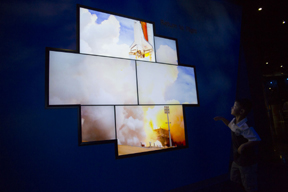
SVC Podcast – Show Notes – Show 148-2
In this edition of the SVC Podcast, SVC Contributing Editor Bennett Liles completes his conversation with Brian Karr of Rockledge Design Group (RDG) about the newly opened Forever Remembered Memorial at Kennedy Space Center. Brian goes into the details of content creation for the new memorial and outlines the process he used to go through high resolution images and video he shot with NASA’s Advanced Imaging Lab. The big moment was when the families of the fallen astronauts viewed the exhibit.
Links of interest:
- Rockledge Design Group (RDG)
- Kennedy Space Center
- Kennedy Space Center Visitor Complex news release on the memorial’s opening
- You Tube video of the opening of the exhibit
Download Podcast Here:
https://s3.amazonaws.com/nb-svc/public/public/149-2_Forever_Remembered__…
From Sound & Video Contractor Magazine, this is the SVC Podcast with Brian Karr of Rockledge Design Group, RDG. Show notes for the podcast are on the web site of Sound & Video Contractor Magazine at svconline.com.
NASA wanted a fitting memorial to the Shuttle astronauts who gave their lives in taking us into space. They called in a familiar face with Brian Karr of Rockledge Design Group, RDG. He went through tons of video and still images to create the video wall portion of the tribute for the families of fallen Shuttle astronauts and other visitors to Kennedy Space Center. The exhibit opened last June and he’s here to tell us how it was created. That’s next on the SVC Podcast.
Brian, it’s great to be back with you for Part 2 on the SVC Podcast with the Rockledge Design Group, known as RDG. We were talking about the Forever Remembered Memorial at Kennedy Space Center. This is a tribute to the Challenger and Columbia Shuttle astronauts who have given their lives in space exploration and there is of course a lot of emotion connected with this. RDG was brought in to create the video wall portion of this exhibit. What did NASA want to say with the video wall that is featured here? I know there were some specific points that they wanted to make.
That’s a great question because what they didn’t want us to do was sort of a rehash of the accidents and sort of the classic footage you see of the accidents either during the liftoff or during the reentry. So really what our goal was to be respectful, to be inspirational, and to sort of continue that thought of these were extraordinary people that gave their lives in the quest for exploring space. So I will tell you in the beginning we were given a lot of footage, we were given a lot of still images, and we really did struggle quite a bit as far as how to create these three different pieces. And the idea was there was sort of the three steps of recovery after the accident. So it was the emotional recovery of what happened and then there was the physical recovery of having to go out and collect all of the debris and pieces and then of course return to flight. Now we’re got to go back and we’ve got to get back to launching again. So when we were going through the material, I think there was two gentlemen from NASA, Mike Ciannilli and Luis Berrios, and there was a gentleman from the Visitor Complex operator Delaware North, Daniel Gruenbaum, and the four of was were sort of struggling because we had all this material, but we were just so afraid of making a slideshow. We really didn’t want it to just kind of be this slideshow of pictures and video. So as we were going through it, it was a day that Luis Berrios and I opened up a box of material that Mike had given us. And what it was, was all of these children’s cards that had been sent in to NASA after each of the accidents. I think I read through maybe five or 10 cards and I just was completely blown away to read what these kids had written. Incredibly powerful and strong and emotional messages, but you could just see that I almost feel like they did a better job with it that probably a lot of the adults did because they were still very hopeful. The kids really could express – they understood why astronauts do what they do. They understood what they were trying to accomplish. And so we kept reading these cards and it just sort of hit us. We’re like wow, this is the story right here. This is how we’re going to tell it is through these children’s cards. So we actually started laying them out in the floor and basically let the children’s messages narrate the story. And that’s really how the three themes came about is by aligning and sort of putting the story together based on these children’s cards. [Timestamp: 4:00]
There must have been just tons of source material to go through to create the content. I know you didn’t want to miss anything. You shot a lot of this yourself but there was video and there were images shot by others years ago with no notion at that time of how this would be used. What was the process that you used to go through all of the source material?
There were, I mean, hundreds if not thousands of still images that are available out there. Especially when you got into the recovery and the debris. In both cases, Challenger and Columbia, they had all these pictures of debris. I was familiar with using DaVinci Resolve as a color-grading tool and I had just started playing a little bit with the editing features in it. And so we organized using all the bin features in Resolve and got everything organized in there. What was really nice is we were able to assemble different frames, different themes, on the timeline and almost instantly kind of jump over to the grading page – to the color page – and put it together and get sort of a first pass grade on it and say hey, is this kind of the emotion? Is this kind of what we want to do with this particular, I’ll call it scene, within the presentation? And so the new editing features in Resolve let us work back and forth between all this material and kind of assembling it and putting together a look all in one package. What it did is it saved us from having to do a round trip to an NLE and that saved a lot of time. You’d have to go out to whatever editor you were using and assemble that and bring it back into Resolve and that’s a real time-intensive process. So to be able to work completely from within Resolve, I think – well, it did two things: It saved us a lot of time. We were definitely on a strict time and budget. And the other thing is having that flexibility to work with that much material and bring it in and do some grading and sort of get the look we want, it definitely led to a couple of moments. We had these a-ha type of moments where wow, that really looks great with that and that’s really kind of the message we were trying to get across. So in that respect, Resolve really helped us a lot. [Timestamp: 6:15]
Once you got all of that together then you had to make the final assembly. How long is the video wall presentation? Is it a continuous loop that it plays?
It is a continuous loop. The first two, the emotional and physical videos are about six minutes. And then the return to flight is a little bit shorter. I think it’s about three and a half. And they just loop continuously. It’s not meant in the style of quick cuts and quick editing and a lot of the type of stuff that you see today. This is a little bit slower-paced and it’s really supposed to take you through a range of feelings as you go through the different videos. [Timestamp: 6:52]
And some of the best experience and preparation for this job was your work with NASA’s Advanced Imaging Lab. What kind of a place is that?
I hate to say this. The listeners of this show – it’s like a kid being in a candy store. I mean really, we had a lot of the latest and greatest equipment. We had our own tracker, which was basically a trailer-based tracking system that we could mount cameras on and track the launches. So before a launch, whatever systems we had, either that we owned or had on loan from manufacturers, we would put together and put on the tracker and then bring it out. We were mainly about three miles away from the shuttle pad where we would set that up. And then of course we also had access to the shuttle pad itself. So we would set up different camera systems on the pad or on the structure next to the shuttle and we were able to get some truly amazing footage. As an example, in one case we had two phantom high-speed cameras that we set up on a 3D configuration just about even with the top of the external tank. So we had this amazing 550-frame-per-second high-speed shot of the shuttle flying through and that was actually shot in 3D. So it was really fun. We had fiber optic communication from the camera slides back to our lab and we had a control center in our lab so we could actually control all of the cameras. And if the lens systems were controllable, we could control all that from the lab. So we would come in about six hours before a launch. We would have everything set up and we would operate all the imaging systems from our lab as a mini control room. It was really, really fun. [Timestamp: 8:33]
When you got this all together and assembled there was a color theme that was part of the message. How does the color theme help tell the story and reflect the emotion at the various stages of the recovery?
Yeah, and that’s where Luis Berrios, the NASA lead designer, came in. He had a specific color theme for each of the different stages. So for the emotional it was much more of a purple and pinkish kind of – not really sad, but a memorial type of feeling. And then we move into the physical recovery, which for Challenger, you’re doing a lot of the recovery on the ocean so you had sort of an ocean blue kind of moving a little bit away from the softer hues of the purples and the pinks. And then as we got into return to flight, we shifted more into that bright sky blue because now we’re returning to flight, we’re launching again, and we’re launching up into the sky. So when you go through the exhibit you’ll see that color change as you go from one wall to the other. [Timestamp: 9:34]
You got it all put together, you got the final product done and you had to have some test subjects for this before showing it to the public. Who were the first people to see the video wall content play on the initial demonstration?
Well, so that’s an interesting story because this memorial, out of respect for the astronauts’ families, it was actually kept very secretive. And so they didn’t want word to leak out before the families had an opportunity to see it and they kind of wanted to let them be the first folks to kind of see it. So up until when the families were able to come and view it, I would say less than probably about 10 people had seen the actual videos. They were mainly internal NASA folks and people working very closely with us. So we did have very good feedback from them, but I will say it was a little bit nerve-racking because nobody had really seen this before it really opened to the public and opened to the families. So for me, I was very nervous. It was an honor to be part of this. It was an honor to work on it, but you also want to do a good job and you certainly want the families to be happy and you wanted to portray these astronauts as the incredible people that they were. And so the feedback that we got from the families was just really, really positive. I think they were very happy with how it came out and how it was very respectful of the accidents and respectful of the people and respectful of the process that we went through. So it worked out very well and at the end of the day I think everybody was very proud of it. And I’ll mention something else about the exhibit is that there’s essentially three parts. There’s the part with the video wall and there’s also a section where each of the astronauts has a case where family members have donated personal items. So you walk through that and you get to really meet each of the astronauts. There’s another section that has two very large openings that are protected, of course, by glass. And this is the first time this has ever been shown to the public. They’re actually two pieces from each of the recovered orbiters. So in the case of Challenger, the sidewall, the piece that was recovered that has the American Flag on it, which is very well in tact as far as the flag on the side of the piece, that is on display and the cockpit windows of Columbia are also on display. And it really, when you walk in and see the two pieces in that room it is a very emotional, very stirring feeling that you get. When you look into those windows of Columbia, those front cockpit windows, I mean it’s almost like you’re looking into the soul of those astronauts of that shuttle. It’s done in a very nice way, very respectful. The lighting is very nice as well. It’s definitely worth going and seeing. [Timestamp: 12:25]
I know you and the creation team are very proud of this project. It has to be a great feeling of accomplishment on the positive reaction to it, especially from the families involved. So what else has RDG got going on?
My company is a little bit different in that we sort of have two branches. We have an engineering side where we design systems and then we have a creative side where – and this is a little bit unique – where we can also develop our own creative content for these kinds of systems we develop. So I am still working in the imaging world. I do work on tracking systems and developing long-range optics and long-range camera systems, so that’s one part of what I’m doing. And then we have some other creative efforts that coming up, which I can’t go in too specifically, but there are some other space-related, exhibit-type projects that we’re working on that I think we’re going to be equally proud of, that you’ll see out there at the visitor’s center at some point in the future. We’ve got some neat stuff coming. [Timestamp: 13:23]
And we’ll be very interested in hearing about those when you get them done. Brian Karr from RDG, the Rockledge Design Group and the video wall of the Forever Remembered Memorial at Kennedy Space Center. Thanks very much, Brian. It was great talking to you.
Yeah, thank you very much for having me.
Thank you for being here with us for the SVC Podcast with Brian Karr of Rockledge Design Group, RDG. Show notes are on the website of Sound & Video Contractor Magazine at svconline.com. Be back with us next week for the SVC Podcast.










